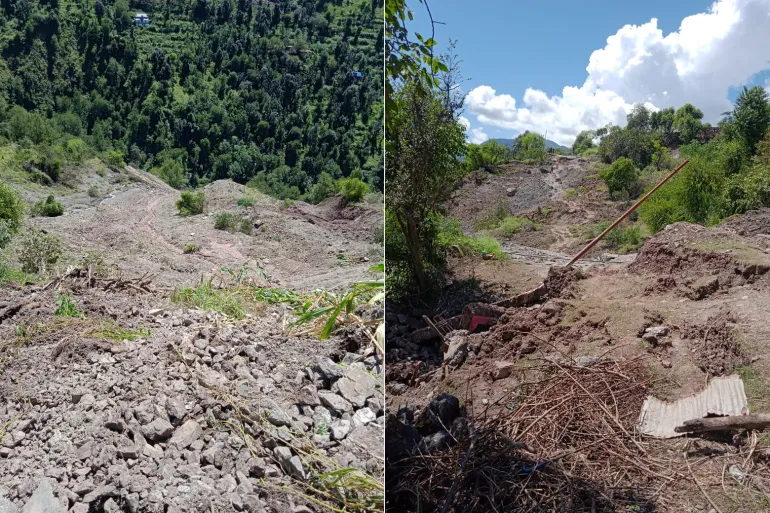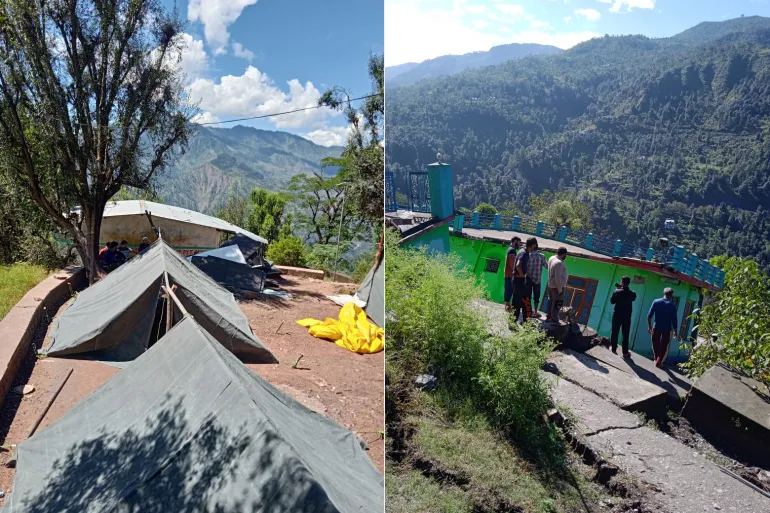India wants COP30 to focus on climate adaptation, but dries up own fund | Climate Crisis News
Indian-administered Kashmir – On the night of September 2, Shabir Ahmad’s home was swallowed by mud and swept into the river after relentless rains triggered a landslide in Sarh village in Indian-administered Kashmir’s Reasi district.
“I had been building my house brick by brick since 2016. It was my life’s work. Only less than a year ago, I had finished constructing the second floor, and now there is nothing,” the 36-year-old father of three children told Al Jazeera.
Recommended Stories
list of 4 itemsend of list
Ahmad’s was among nearly 20 houses in Sarh lost to the Chenab River that night, including one belonging to his brother, as dozens of families helplessly watched their farmlands, shops and other properties worth millions of rupees vanish without a trace.
“We don’t even have one inch of land left to stand on,” said Ahmad from a government school in Sarh, where his family and other villagers were sheltering after the deluge.
The tragedy at Sarh was among the latest of increasingly frequent climate disasters across India that destroy lives and livelihoods, and displace millions of people to an uncertain future.

According to the Geneva-based Internal Displacement Monitoring Centre (IDMC), climate-related disasters forced more than 32 million people from their homes in India between 2015 and 2024, with 5.4 million displacements recorded in 2024 alone – the highest in 12 years. This makes India one of the three nations most affected by internal displacements due to climate change in that period, with China and the Philippines being the top two.
Moreover, in the first six months of 2025, more than 160,000 people were displaced across India due to natural disasters, as the country received above-average rainfall, triggering huge floods and landslides, and submerging hundreds of villages and cities.
Zero adaptation money for two years
To help millions of people like Ahmad who are vulnerable to the climate crisis, India’s Ministry for Environment, Forest and Climate Change launched a National Adaptation Fund on Climate Change (NAFCC) in 2015. Its goal was to finance projects that help communities cope with floods, droughts, landslides, and other climate-related stresses across India.
Managed by the National Bank for Agriculture and Rural Development (NABARD), the flagship scheme supported interventions in agriculture, water management, forestry, coastal protection, and climate-resilient infrastructure. Between 2015 and 2021, it financed more than two dozen projects, benefitting thousands of vulnerable households.
During a roundtable in Brazil’s Belem city last month – before the 30th United Nations climate change conference, or COP30, which officially opened on Monday – India’s minister for environment, forest and climate change, Bhupender Yadav, said the global meet should be the “COP of adaptation”.
“The focus must be on transforming climate commitments into real-world actions that accelerate implementation and directly improve people’s lives,” he said, according to a statement released by the Indian government on October 13. He highlighted “a need to strengthen and intensify the flow of public finance towards adaptation”, said the statement.
In another statement last Tuesday, a day after COP30 opened, India said climate “adaptation financing needs to exceed nearly 15 times current flows, and significant gaps remain in doubling international public finance for adaptation by 2025”.
“India emphasised that adaptation is an urgent priority for billions of vulnerable people in developing countries who have contributed the least to global warming but stand to suffer the most from its impacts,” said the statement.
But the actions of the Indian government back home do not match those words at the climate summit.
Government records show NAFCC received an average of $13.3m annually in the initial years of its launch. But the allocation steadily declined. In the financial year 2022-2023, the fund’s spending was just $2.47m. In November 2022, the Ministry of Environment, Forest and Climate Change moved NAFCC from the category of a government “scheme” to a “non-scheme”, providing no clear outlay for funds.
Since the financial year 2023-2024, zero money has been earmarked for the crucial climate adaptation fund.
As a result, several climate adaptation projects in areas prone to floods, cyclones and landslides have been stalled even as widespread climatic devastation continued to kill and displace people. While presenting the federal budget in parliament in February this year, Finance Minister Nirmala Sitharaman did not even include the words “climate change” and “adaptation” in her hour-long speech.
“Announcing lofty adaptation goals abroad while starving the fund that safeguards our own citizens is misleading and a moral failure,” Raja Muzaffar Bhat, an environmental activist in Indian-administered Kashmir, told Al Jazeera, calling Yadav’s statements in Brazil “a gross distortion of reality and a dangerous distraction”.
Al Jazeera reached out to the Ministry of Finance and the Ministry of Environment, Forest and Climate Change for their comments on cutting NAFCC funds, but has not received any response.
An official in the Environment Ministry, however, defended the government’s shift in funding priorities, claiming the authorities have not abandoned climate adaptation efforts.
“Funds are now being channelled through broader climate and sustainability initiatives rather than standalone schemes like the NAFCC,” the official told Al Jazeera on condition of anonymity because he was not authorised to speak to the media.
‘Climate injustice at its most blatant’
Meanwhile, climate crises continue to kill and displace people across India.
In the Darbhanga district of Bihar, India’s poorest state, 38-year-old Sunita Devi has been displaced five times in seven years as floods in the nearby Kosi River repeatedly destroyed her mud house built on bamboo stilts.
“We live in fear every monsoon. My children have stopped going to school because we shift from camp to camp,” she said, holding on to the family’s only lifeline: A government ration card that allows them to buy food grains at subsidised rates or get them for free.
This year saw one of the worst monsoons across India, as above-average rains killed hundreds and displaced millions. In Bihar alone, floods affected more than 1.7 million people, killed dozens and submerged hundreds of villages.
In Odisha, another impoverished eastern state, fisherman Ramesh Behera*, 45, watched his house in Kendrapara district’s Satabhaya village collapse into the Bay of Bengal in 2024, as rising seas continue to erase entire hamlets. “The sea swallowed my home and my father’s fields. Fishing is no longer enough to survive,” he told Al Jazeera.
Behera was forced to give up his family’s traditional livelihoods – fishing and farming – and was driven into distress migration to survive. He now works as a manual labourer in Srinagar, the main city in Indian-administered Kashmir.
In West Bengal state’s Sundarbans Islands, one of the largest mangrove forests in the world, rising seas and coastal erosion have consumed lands and homes, forcing thousands of families in the fragile ecosystem to relocate.
In the southern state of Tamil Nadu’s Nagapattinam district, 29-year-old Revathi Selvam says saltwater intrusion from the Bay of Bengal has poisoned her farmland and their paddy harvest has collapsed.
“The soil is no longer fertile. We cannot grow rice any more. We may have to leave farming altogether,” she told Al Jazeera, adding that many in her village are considering migrating to the state capital, Chennai, to work as construction workers.
In the Himalayan state of Himachal Pradesh, 27-year-old hotel worker Arjun Thakur saw his livelihood vanish when a cloudburst in 2024 buried the small tourist lodge where he worked. “The mountain broke apart. I saw houses collapse in seconds,” he recalled.
Thakur now stays with his relatives in the state capital Shimla, unsure if he can ever return to his native place.

Yet, with funds for NAFCC gone, people like Devi, Behera, Selvam and Thakur have no access to a government scheme that helps them cope with their tragedies.
A government official, who previously worked with NAFCC, told Al Jazeera several schemes approved by the government under NAFCC were never implemented after funds began to dry up as early as 2021, exposing thousands of households to a recurring climate crisis.
“The fund was created to help vulnerable communities adapt before disasters struck, and to reduce the kind of repeated displacement we are now witnessing,” the official said on condition of anonymity because he was not authorised to speak to the media.
“Once the allocations stopped, states lost a key channel to protect people living on the front lines of floods, landslides, and droughts. Now, these families are left to rebuild on their own, again and again.”
Activist Bhat said the government’s attitude to the NAFCC “signals that adaptation is no longer a priority, even as India faces record internal displacement from climate extremes”.
“People are losing homes, farms, and livelihoods, and the government has left them entirely to their fate. If this continues, the next generation will inherit a country where climate refugees are a daily reality,” he said.
“This is climate injustice at its most blatant.”
‘Migration no longer a choice but a survival strategy’
Climate Action Network South Asia is a Dhaka-based coalition of about 250 civil society organisations, working in eight South Asian countries to promote government and individual action to limit human-induced climate change. Its estimate says roughly 45 million people in India could be forced to migrate by 2050 due to the climate crisis – a threefold increase over current displacement figures.
“We are a vast nation with hot and cold deserts, long coastlines, and Himalayan glaciers. From tsunamis on our shores to flash floods, cloudbursts, and landslides in the mountains, we face the entire spectrum of climate extremes,” Bhat told Al Jazeera.
Bhat said it is not just nature causing displacement, but also unchecked “development” of vulnerable areas.
“Earlier, floods or cloudbursts were occasional, and population density was low. Now, haphazard construction around mountain passes, waterways and streams, along with rampant deforestation, has amplified these disasters,” he said.
“People who once fled New Delhi’s air pollution to settle down in [the Himalayan states of] Himachal Pradesh or Uttarakhand now find themselves living under a constant threat of landslides. Migration is no longer a choice but a survival strategy.”
Bhat warned that neglecting people affected by climate-related displacement could cause the world’s largest climate migration crisis.
“We are no longer behaving like the welfare state promised in our constitution. We pay taxes like a developed country but get services that leave people to die in a climate crisis… We are utterly unprepared for the mass migrations that will inevitably come from both our mountains and our plains,” he said.
Back at the temporary government shelter in Kashmir’s landslide-hit Sarh village, Ahmad fears an uncertain future for him and his family.
“If land and shelter are not provided, we will not merely be homeless; we will become refugees in our own land, cast aside without place or protection,” he said.
“When the state neglects the consequences of climate change, it issues a declaration: You are free to drown, but not free to rebuild.”